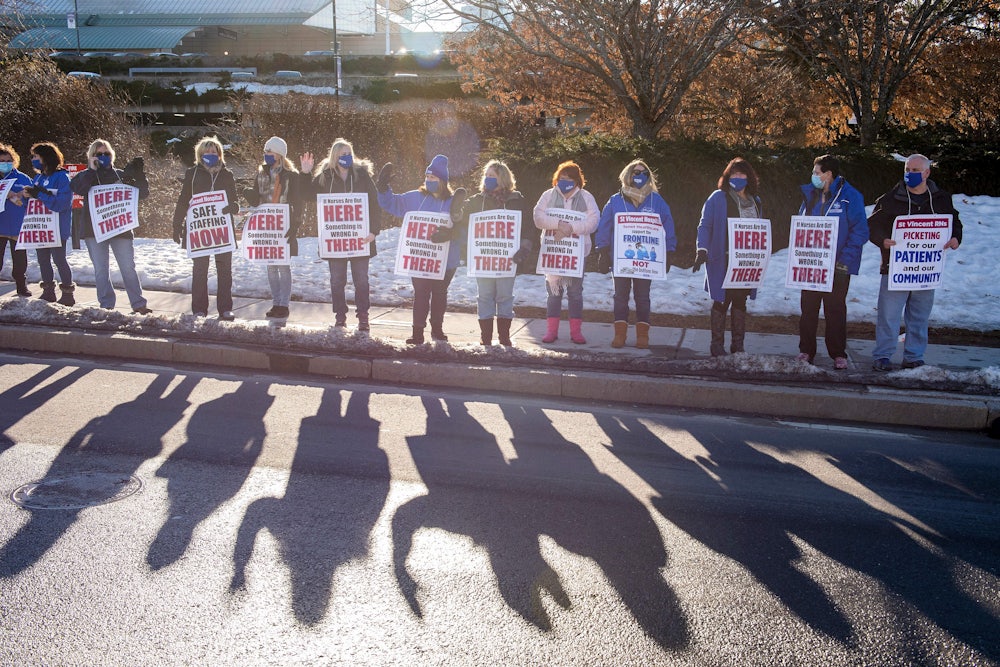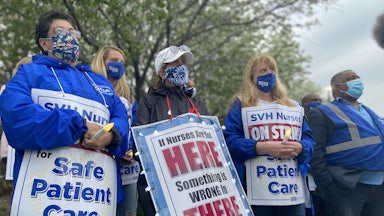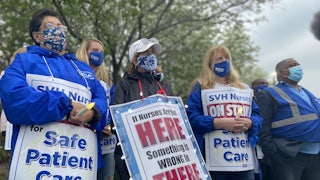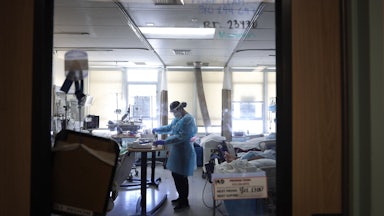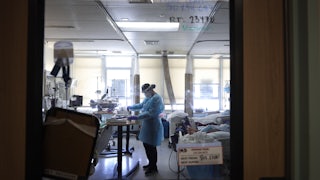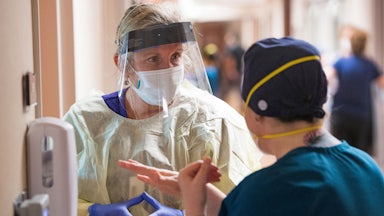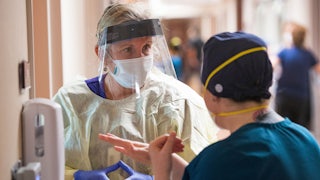Carla LeBlanc had been working at St. Vincent Hospital in Worcester, Massachusetts, for five years when her union, representing over 800 nurses, began negotiating a new contract with management. Like many of her colleagues at St. Vincent, LeBlanc assumed that a contract would soon be in place.
Even after negotiations stretched out over two years and nurses began talking of a strike, LeBlanc was hopeful. “I was telling everybody we’re never going to go on strike,” she told me. “I thought, they can’t force us to go on strike in the middle of a pandemic.”
But the nurses did strike, for nearly 10 months, in what became the longest labor action of 2021. The strike ended on January 3, when, after months of the hospital’s strike-breaking efforts and threats of permanent replacement, nurses finally secured a decisive win. The hospital agreed to implement new raises and safety regulations, limit the number of patients assigned to nurses in some departments, and address staffing shortages as part of the nurses’ new contract.
Increased staffing was the most important of these wins, because at its heart, the St. Vincent strike was about the same issue animating nurses’ fights across the country: dangerously understaffed hospitals.
In 2004, St. Vincent was bought by Vanguard Health Systems, Inc., which in turn was acquired by Dallas-based Tenet Healthcare Corporation, currently the second-largest for-profit conglomerate in the country, in 2013. Acquisition by Vanguard and especially Tenet began St. Vincent’s drastic transformation from a Catholic community hospital to a business. In interviews, a dozen striking nurses talked about the everyday realities of this for-profit shift, how it put nurses and patients at risk, and why, for them, returning to work without a higher nurse-to-patient ratio was simply not an option.
Karen Soper began at St. Vincent as a nurse’s aide in 1996. When I asked her about the biggest change she has seen in her two decades there, Soper answered without missing a beat: “Patients are sicker now.” This is not, she explained, because people are in worse health today than they were in 1996. Instead, the rise in acuity—the severity of each admitted patient’s sickness—has to do with revenue maximization.
“When I first started nursing,” Soper told me, “a lot of patients would stay at the hospital longer. This means they wouldn’t be quite as critically sick when they were here.” In contrast, patients today are not admitted to the hospital until they are as sick as they can get, so they can be charged the highest amounts for the shortest stay.
Tenet explicitly identifies high-acuity cases as cash cows. “We are encouraged that net revenue per case is almost 10 percent higher than in 2019,” Tenet Healthcare CEO Saum Sutaria reportedly told investors in an October 2021 call. “Our higher-acuity services are showing an even, enhanced growth rate.”
For nurses, higher acuity means that every minute patients spend in the hospital requires hands-on, critical care, especially since when patients do get admitted, they come to the hospital with multiple problems—comorbidities—that may not have triggered hospitalization on their own but nevertheless need to be addressed. In the cardiac telemetry unit where Soper works, a patient could be admitted for cardiac issues and separately require a blood transfusion or a peritoneal dialysis during their short time there. Each patient thus carries a higher burden of minute-to-minute care in 2021 than in the 1990s.
The other part of higher acuity is early discharge. “When I first started at St. Vincent five years ago, a hip replacement patient would stay at the hospital for three to four days after their surgery,” LeBlanc told me. “When we walked out on strike on March 8, they were being discharged the day after that surgery.”
Quicker discharges mean worse care and poorer recoveries. “Sending people home faster means a lot more teaching and setting up a lot more services for them,” said LeBlanc. “So if I have a patient just diagnosed with diabetes and I find out they are getting discharged that afternoon, I now have to explain to them the signs and symptoms of low [blood pressure], teach them how to count carbs, use a glucometer, and inject insulin while I have four others needing to get ready to go to surgery or trying to get out of bed.” It is unsurprising that these conditions compromise the quality of care.
Prematurely discharged patients often end up readmitted. When it comes to readmission due to poor care, Massachusetts ranks among the worst states in the country. For hospitals, however, readmitted patients means yet higher revenue.
In a for-profit system, hospital beds become precious real estate that must be optimized. “They know the cost of each patient’s care,” LeBlanc said. “If someone pays $1,000 for a surgery, they’re not going to say, ‘Let’s have them recover here and lose us another $1,000.’”
The pressures of rising acuity were compounded by staffing cuts. According to longtime nurse Patty Warman, by 2019, the hospital was staffed at an absolute bare-bones level. “They’d tell us there’s no personal care assistant, one-on-one sitter, secretary, or resource nurse,” she said. “So when there weren’t enough supplies—sandwiches or ginger ale—you as the nurse are running around to different units to find them or you’re buying the food yourself to give patients because you feel bad.”
Nurses were expected to pick up all the slack created by understaffing. Soper told me that in addition to their actual jobs of patient care and education, nurses also answered calls, did toileting, took vitals, and more. “We were constantly looking for someone to help boost the patient, or get them out of bed, or slide patients on and off stretchers, or push stretchers,” she recalled. But transportation was short-staffed, too, so nurses had to do this work themselves.
In time, nurses were even doing the cleaning. “They started no longer having sterile processing come to the floor for cleaning,” Warman said, “which meant it was the nurses’ job to clean the equipment.” During the pandemic, some units even cut housekeeping, adding on even more cleaning work.
Amid all of this, the actual work of nursing was compromised. Aimee Albani told me that in the progressive care unit where she worked, nurses administered major drips that required taking vitals every few minutes while also getting in and out of protective equipment, doing charts, and more. When an emergency happened in this situation, Albani said, “you might have to cut corners, like not putting on all the protective gear or not putting it on appropriately. You would put everyone at risk to save money.”
The real kicker here, Albani pointed out, was that the hospital was even sending the staff that they did have home. Nurses worked on a flexible scheduling system so they could be asked to come in and out of work, per the “just-in-time” model of management. To eliminate any “extra” staff, the hospital carefully kept the number of filled beds under the tipping point for requiring an extra nurse and sent staff home if it was a “slow” day. The E.R. going into Code Red in this situation created panic. Staff that were sent home were urgently called back.
Chronic understaffing could have deadly consequences, the Massachusetts Nurses Association said in a press release earlier this year: “The onset of serious preventable complications, suicidal patients being left without one-on-one monitoring, and even preventable deaths directly attributable to inadequate staffing levels.”
The explosive combination of intentional understaffing and increased acuity also makes for an unhygienic hospital. Nurses told me of patients waiting for painkillers or food, or lying in their own urine or feces, waiting for help for hours.
In an email, St. Vincent’s P.R. team wrote that “these accusations were disproven time and again,” referring to their previous statements: “The hospital is not only safe, but has performed well and continued to improve.” The hospital calls any claims to the contrary “MNA disinformation.”
But it was rank-and-file nurses who told me that, in contrast to the hospital’s claims of “strong infection prevention practices,” during Covid-19 nurses received no hazard pay, sick days, or, during the first wave, functional protective equipment. “We were told, ‘Oh, you can use a single mask for three shifts.’ Then the next day they said five shifts,” Soper said, recalling being handed a Tupperware container to poke holes into and store used masks between shifts. “We were doing the opposite of what is safe, what is normal.”
In 2020, Tenet posted a profit of $414 million, spent a billion dollars expanding its operations, and prepaid its corporate debts, all while shooting down what it called the “aggressive staffing levels” demanded by the nurses at St. Vincent. In the same early pandemic period, nurses said they had filed over 600 “unsafe staffing” reports informing management in real time about problems such as “an increase in patient falls, an increase in patients suffering from preventable bed sores, [and] potentially dangerous delays in patients receiving needed medications and other treatments.” Management did not respond to these complaints by spending money on care. Labor and Delivery Nurse Deirdre Simpkins suggested that this is because key decisions about patient care at St. Vincent were being made in boardrooms, not at bedsides. The CEO of St. Vincent, for instance, studied chemical engineering in undergrad but has an MBA from Harvard Business School.
Nurses are the ones who know what good care looks like, and yet they are rarely seen as experts in their field. Marie Ritacco, a postanesthesia care nurse at the hospital, thinks that this has something to do with the fact that nurses are overwhelmingly female. “They think that just because we are women, we are built to care for people and can do it under any conditions,” Ritacco said.
The image of a motherly nurse is used not only to discredit nurses’ expertise but also to guilt them into doing care work under dangerous conditions. “In the prestrike days,” LeBlanc recalled being asked, “What would Florence Nightingale do? Would she ‘abandon’ her patients and strike?”
“It was like they expected me to be some kind of martyr,” she said. “But I am a professional, this is a job, and it should be taken seriously.”
After an arduous struggle, St. Vincent nurses won their fight to be taken seriously as experts in patient care. LeBlanc expressed hope that other nurses will follow her union’s example and challenge the for-profit takeover of hospitals. This is a high-stakes fight. “If nurses don’t win,” LeBlanc noted grimly, “it’s going to be us in those hospital beds, and it’s going to be worse than it is now.”
